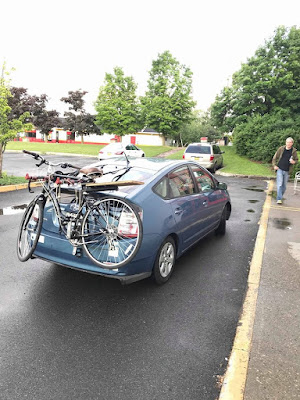Summer for a professional plein air painter can involve as much driving as painting.
 |
| Cape Blomiden makes its own cloud, by Carol L. Douglas, was painted during a rainstorm in the first annual Parrsboro International Plein Air Festival. |
One of my students missed last weekend’s workshop due to a painful flareup of plantar fasciitis. Another student, himself a doctor, told me about taking the disease into his own hands. He simply stretched the offending tissue until it audibly tore. “The relief was instantaneous,” he told me as I stared at him aghast.
My little Prius has done something similar. It has, over the last year, developed a loud scream at high speeds. Turning up the radio was useless. I had the tires rotated to see if that helped. No luck. A front wheel bearing was replaced in March; I replaced its mate two weeks ago. The right rear brake locked up while my car was in Logan Airport long-term parking in April. That wasn’t the root of the noise either. Meanwhile, every month I’ve been spending more money on this car than the payment on a Ford F-150.
| I appreciate AAA’s tow service, but I’ve seen too much of it recently. |
But even the money hasn’t been the real problem. “It’s no longer reliable,” I lamented to my husband. Next week I drive alone to Parrsboro, NS, where I’m painting in the second annual Parrsboro International Plein Air Festival. There are some lonely stretches up that way, and I don’t like the idea of getting stranded. I’ve started car shopping, but I don’t have the time to do proper research.
Meanwhile, I’ve had a busy spring. On the night of my daughter’s wedding rehearsal, I stopped for a light at a busy intersection. I woke up seconds later to find that I’d rolled right into the line of oncoming cars.
I have more than a million miles of accident-free driving under my belt and I’d like to keep it that way. Yesterday when I found myself blinking away sleep on the New York State Thruway, I did something I never do: I relinquished the wheel to my co-pilot. Thus, it was he, not me, who was driving when a tire burst on the interstate.
 |
| Two Islands in the Rain, Carol L. Douglas, also from Parrsboro International Plein Air Festival |
In the end, this turned out to be the Prius healing itself. A few hours later, we were back on the road. The sound that’s been plaguing me for months was gone. It was a defective tire after all.
We rolled into Rockport around the time that the fishermen are up rubbing the sleep from their eyes and checking the weather. The thermostat in my car read 43° F. and it was foggy and pouring.
I have a short tight week here in Maine. I leave to teach watercolor on the schooner American Eagle on Sunday evening. After we dock, I leave directly for Parrsboro, NS.
 |
| Teaching watercolor aboard American Eagle mercifully involves no driving. The dock is just minutes from my home. |
I’ll be missing the opening reception for the latter, but Poppy Balser kindly stopped by on her way to Paint Annapolisto collect my boards for me. She’ll get them stamped so I don’t have to spend half of my first day there trying to find someone to stamp them for me. I’ll just have to find Poppy.
 |
| And the eco-warrior is back on the road, all healed. |
This is nothing unusual; it’s the life of many of my friends each summer. We sort events into boxes. Sometimes we can stop at home, swap the boxes, and do our laundry. But often we stack our calendars up in the back of our vehicles: frames and supports for the different events share trunk space. If we’re crossing the border, we take a deep breath as we approach Customs. We’re not breaking the law, but a search of our cars will result in an awful mishmash of our supplies.
















